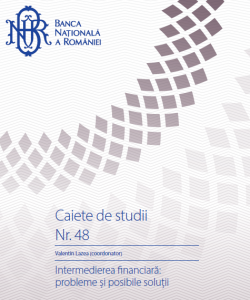 The ease with which companies turn to insolvency is one of the structural obstacles to a faster credit expansion, according to a group of economists coordinated by Valentin Lazea, published in the latest issue of the Study notebooks of the National Bank of Romania (BNR).
The ease with which companies turn to insolvency is one of the structural obstacles to a faster credit expansion, according to a group of economists coordinated by Valentin Lazea, published in the latest issue of the Study notebooks of the National Bank of Romania (BNR).
„In practice, it was found that the Romanian insolvency law allowed too easily that interest groups controlling a company or being controlled by a firm could declare insolvency, disadvantaging other groups of creditors, including banks” it is said in the „Financial intermediation: problems and possible solutions” study.
Consequently, the rate of recovery for creditors following the initiation of the insolvency procedure for a firm is the lowest in Romania (29.2%), compared to 56.3% in the Czech Republic, 54.5% in Poland, 53.6% in Slovakia, 38.8% in Hungary and 31.7% in Bulgaria, according to the World Bank data quoted by the study.
In contrast, Romania has the highest insolvency rate (number of companies in insolvency relative to the total number of companies) of about 5.67%, compared to 3.84% in Hungary, 0.47% in the Czech Republic, 0.35% in Bulgaria, 0.04% in Poland and 0.10% in Slovakia. Only Serbia surpasses Romania at the insolvency rate, with 7.93% of all companies.
The number of trading companies and individual companies that started the insolvency procedure increased by 6.07% compared to the same period in 2016, to 5,365 units in the first seven months of this year, as shown in the data published on the website of the National Trade Register Office (ONRC).
Most of the companies and PFAs in insolvency are in Bucharest, respectively 1.193, up 12.23% compared to January – July 2016, the capital city being followed by Iasi county with 335 cases (+ 9.12%) and Bihor county with 295 cases (-9.2%).
Most insolvencies were in the wholesale and retail trade field, repair of motor vehicles and motorcycles – 1,621, up 2.47%.
Also, 8,969 companies have suspended their activity (-17.36%) and 15,775 have been dissolved, which represents a decrease by -19.88%.
According to the BNR study, among the „causes leading to a too easy access to insolvency”, it is noted:
- Too low debit threshold at which an application for insolvency may be filed – 40,000 lei, a threshold which should be increased by „establishing a reference element (for instance – identified from the analysis of the data published in the Insolvency Procedures Bulletin related to the insolvency cases)”;
- Debts owed to shareholders and directors of affiliated companies should no longer be considered when establishing the threshold, as „artificial intra-company/intragroup receivables can be created for group companies to enter insolvency”;
- The short term for judging the debtor’s request, which would lead to a „shallow analysis of the application” and the opening of the procedure;
- The possibility of „abusive applications for opening the insolvency proceedings for a debtor, which will prove during the trial that it has the money available for paying the debts.” A solution would be „the requirement of exhaustion of other procedural steps to recover the claim, imposed to the creditor (for instance, the payment order procedure provided for in title IX of the Code of Civil Procedure), prior to submitting the application for opening the insolvency.
- The difficulties encountered in practice by the legal provisions to attract the liability of the management and/or supervisory bodies members as well as any other persons who contributed to the insolvency state, because:
- Used the assets or credits of the legal person for their personal benefit;
- Run activities in the personal interest, under the cover of the legal person;
- Decided, for personal benefits, to continue an activity that clearly led the legal person to default;
- Kept fictitious accounts, made some accounting documents disappear;
- Diverted or concealed some of the legal entity’s assets or fictitiously increased its liability;
- Used ruinous means to obtain funds for the legal entity with the purpose of delaying the cessation of payments, and many other fraudulent actions.
„The involvement of shareholders or associates in the management activity and/or supervising the debtor is difficult to prove, provided that the debtor, a legal entity, has specialized structured in charge, so that the accountability of shareholders or associates is difficult to establish”, according to Law 85/2014 on insolvency, says the study quoted.
BNR study states that it would be necessary:
- „To regulate clear sanctions for the debtor’s associates/shareholders (for instance to be forbidden to establish firms, to carry out within other entities, directly or indirectly, similar activities to those that became subject to insolvency, during the reorganization or bankruptcy period, as well as within the following 3-5 years after the completion of the procedure);
- The regulation of patrimonial sanctions for associates/shareholders, regardless of the criminal nature of the sanctions applied;
- Reviewing the provisions about the actions for which the accountability of the company’s management and/or supervisory structures and of any other person can be attracted so that the facts and culpability of individuals to be easier to prove.”
Dimension of risk
Almost half of the companies that are active in Romania have a high insolvency risk, according to a recent Coface report quoted by Agerpres.
„The very high share of companies with a major risk of insolvency is explained by the phenomenon of polarization of Romanian companies, much stronger compared to what we see in Hungary, Poland or the Czech Republic. For example, the largest 10% of the Romanian firms owned almost 91% of the total revenues registered by the whole business community at the end of 2015, while this share is much lower in Hungary (72%), Poland (68% %) or the Czech Republic (59%),” the document says.
99% of the Romanian companies are struggling for a market share of maximum 33%, against of very aggressive competition and a black economy much higher than the average registered in the EU.
„7 out of 10 companies pay their suppliers later compared to the average period of the debt collection and stock rotation. Of them, 60% finance their long-term investments, 30% repay their long-term bank loans (the balance of bank loans granted to companies declines by about 5% annually) and/or pay dividends (against the advantageous background of a tax reduced to 5%), while 10% finance companies from the group,” the source mentioned says.
According to Coface, the supplier credit balance has doubled since the impact of the financial crisis till now and increased from 168 billion lei (2007) to 340 billion lei (2016), while the bank credit balance increased by only approximately 30 billion lei.
„The average debt collection period increased from 60 days (2007) to almost 114 days (2015), and Coface’s estimates point to 118 days for 2016. Practically, a Romanian company’s insolvency in 2017 will generate double financial losses for the business partners. Not accidentally the first quarter of this year started with a unique mix: the historical minimum of the newly open insolvencies and the maximum financial impact (losses caused to creditors) spread within the business environment. By establishing payment deadlines, suppliers are the largest creditors of companies, with the commercial credit amounting to 42% of the total debts (compared to 29% in 2008), while the bank credit amounts to only 21% (compared to 24% in 2008),” says Coface.









